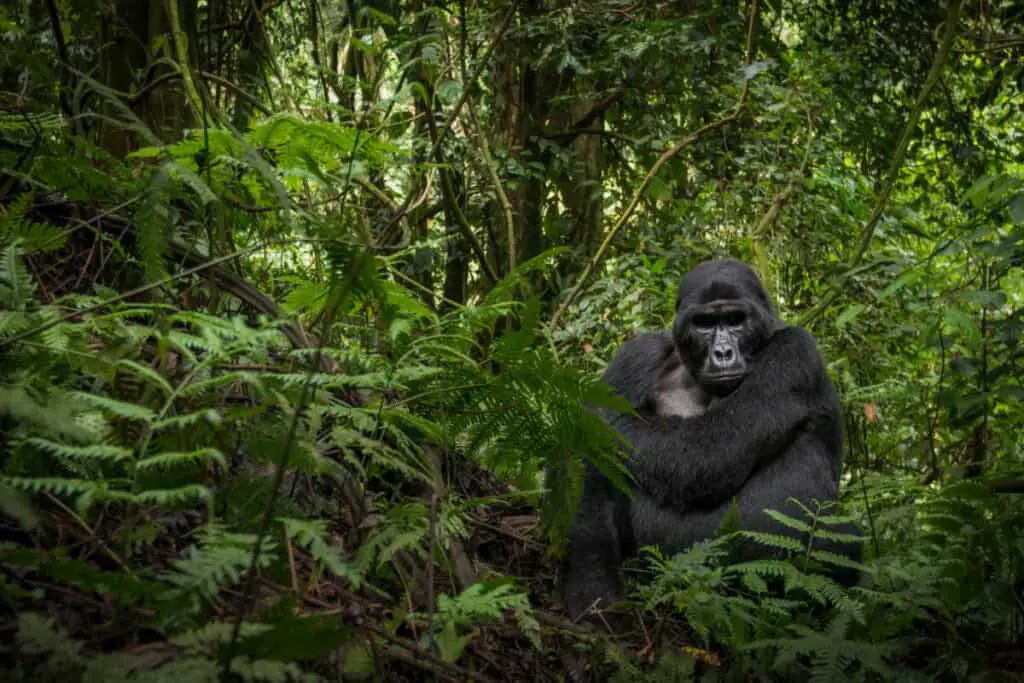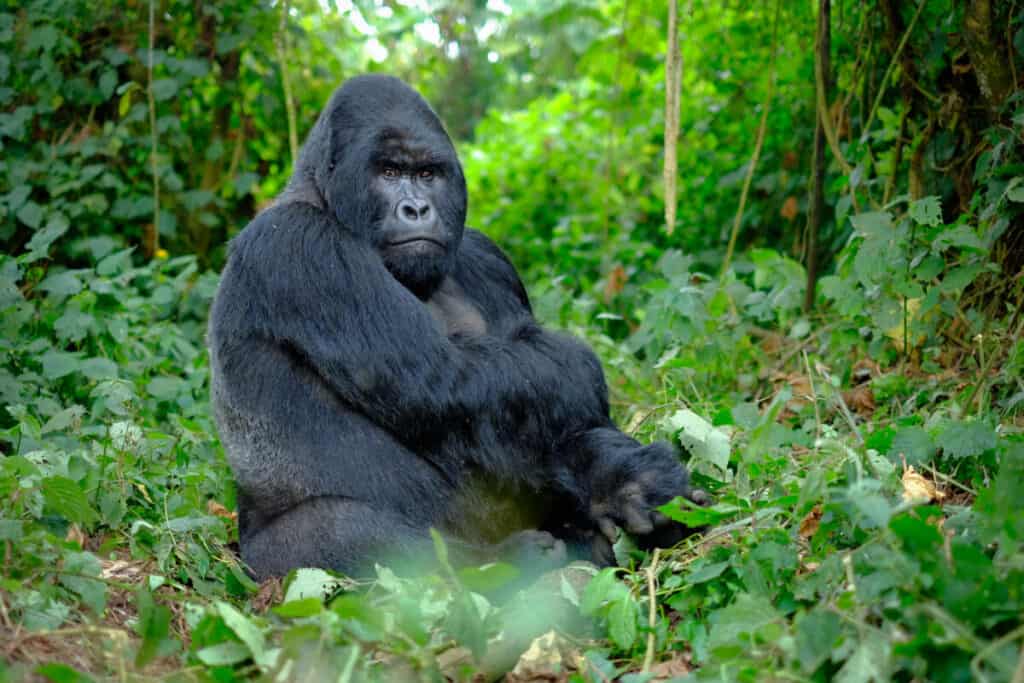The mountain gorilla is a subspecies of the eastern gorilla and one of the most endangered primates in the world.
This species is found only in two isolated populations, one in the Virunga volcanic mountains of Central Africa, spanning across Rwanda, Uganda, and the Democratic Republic of Congo, and another in Uganda’s Bwindi Impenetrable National Park.
The current population size estimated by the International Union for Conservation of Nature (IUCN) is approximately 1,063 individuals.
Mountain gorillas are renowned for their large body size, long hair on their back and arms, as well as their social behavior.
Adult males can weigh up to 200 kilograms while females average around half that weight.
These primates spend most of their time eating leaves and stems from over 140 plant species available within their habitat range.
Although they mainly inhabit montane forests at elevations between 2,300 to 4,500 meters above sea level, these animals occasionally venture into lower areas where human activities take place.
Despite conservation efforts aimed at protecting them from poaching and habitat destruction, this iconic species continues to face numerous challenges that threaten its survival in the wild.

Habitat And Distribution
The mountain gorilla, scientifically known as Gorilla beringei beringei, is a subspecies of the eastern gorilla found in two isolated populations.
One population inhabits the Virunga Massif, which spans across Rwanda, Uganda, and the Democratic Republic of Congo (DRC), while the other population lives in Bwindi Impenetrable National Park in southwestern Uganda.
The geographic range of this species is therefore limited to these specific areas.
Due to human activity such as agriculture, logging, mining and infrastructure development, habitat fragmentation has become a significant threat to the mountain gorilla’s survival.
As their habitats are destroyed or altered by humans encroaching on their territory, it limits their access to food sources and reduces genetic diversity within populations.
Conservation efforts have been implemented to mitigate these threats through protected areas and ecotourism initiatives that provide support for local communities living around these areas.
However, continued monitoring and conservation measures will be necessary to ensure the long-term survival of this endangered species.
Physical Characteristics
Mountain gorillas are one of the largest primates in the world, with males weighing up to 400 pounds and standing at a height of over five feet. They have long, thick fur that ranges from black to dark brown in coloration, providing them with insulation against the cold mountain climate where they reside. Additionally, their broad chests and powerful arms make them well-suited for climbing trees and navigating through difficult terrain.
Despite being genetically similar to other gorilla subspecies, mountain gorillas exhibit unique adaptations that enable them to survive in their particular environment. For example, their larger size allows them to better withstand colder temperatures than their lowland counterparts. Mountain gorillas also possess longer hair on their bodies compared to other gorilla species which helps protect against moisture retention when it rains frequently in high-altitude forests; this adaptation is necessary as there are few dry areas available for sheltering during rainfall events.
Furthermore, due to limited genetic diversity within their population caused by habitat fragmentation and hunting pressures over time periods so great that researchers can only speculate about how things were before human impact began affecting these populations negatively- further studies will be needed if we want more information regarding what might have been lost or gained during those times…
Social Behavior And Communication
Coincidentally, mountain gorillas exhibit complex social behavior and communication patterns. They live in groups of up to 30 individuals led by a dominant silverback male who is responsible for mating with the females and protecting the group from external threats. The dominance hierarchy within these groups is determined through physical confrontations between males, which result in displays of chest-beating, vocalizations, and other gestures.
Vocalizations are an essential part of gorilla communication, ranging from grunts and hoots to roars and screams that can be heard over a mile away. These sounds convey information about the animals’ location, emotional state, and intentions towards others in their group or nearby.
Additionally, gorillas use various body postures such as standing upright on two legs or beating their chests to signal aggression or submission to other members of their group. Dominance hierarchies exist among both males and females in mountain gorilla groups. Physical confrontation determines the rank order within the dominance hierarchy.
Overall, it is clear that social behavior and communication are integral components of mountain gorilla life. These behaviors allow them to navigate complex social relationships effectively while ensuring survival in challenging environments.
Diet And Feeding Habits
Social behavior and communication play a crucial role in the life of mountain gorillas. These primates are highly social animals that live in cohesive groups led by a dominant silverback male. Mountain gorillas communicate with each other using a variety of vocalizations, body postures, and facial expressions. They also use scent marking to communicate their territory boundaries.
Moving on from social behavior and communication, foraging habits and preferred foods are another important aspect of the mountain gorilla’s lifestyle. The diet of these primates mainly consists of vegetation such as leaves, stems, shoots, roots, bark, and fruits. However, they have been observed to occasionally eat insects as well. Gorillas spend most of their day foraging for food, and their diet can vary depending on seasonal changes in availability. Their preference for certain plant species is believed to be influenced by factors such as taste and nutritional content.
| Preferred Foods | Foraging Habits |
|---|---|
| Leaves | Spend majority of day foraging |
| Stems | Travel long distances when necessary |
| Shoots | Can climb trees to access higher vegetation |
| Roots | Will dig up soil if necessary |
| Bark | Occasionally eat insects |
| Fruits | Diet varies based on season |
Overall, understanding the foraging habits and preferred foods of mountain gorillas provides valuable insight into their ecological niche and survival strategies. As herbivores living in dense forested areas where food resources can be scarce at times, it is essential for them to efficiently locate and consume the most nutritious foods available to maintain good health and reproduction success.
Threats To Survival
The mountain gorilla faces an uncertain future, as it continues to be threatened by various factors. Despite conservation efforts, the species remains critically endangered with only approximately 1,000 individuals left in the wild. The fate of these majestic primates hangs on a delicate balance that can easily tip towards extinction.
Poaching is one of the main threats to their survival. Gorillas are hunted for their meat and body parts which are used for traditional medicine or sold as souvenirs.
Additionally, human encroachment has led to habitat loss and fragmentation, forcing gorillas into smaller areas where they are more vulnerable to diseases and other risks.
It is crucial that we address these issues if we want to ensure the long-term survival of this magnificent species.
Sub-themes:
- Habitat destruction
- Clearing forests for agriculture
- Logging activities
- Disease outbreaks
- Transmitted from humans or domestic animals
- Affects viability of populations
- Climate change effects
- Alters vegetation patterns
- Changes weather patterns
- Leads to habitat loss and food scarcity for wildlife.
Conservation Efforts And Successes
Conservation efforts for the mountain gorilla have been ongoing for several decades due to their critically endangered status. One of the most successful approaches has been community involvement in conservation efforts. Local residents are educated about the importance of conserving the habitat and wildlife, and they become active participants in protecting the natural resources. This approach has resulted in reduced poaching incidents and increased protection for mountain gorillas.
Another strategy that has proved successful is ecotourism. The revenue generated from tourists visiting national parks where mountain gorillas reside helps fund conservation activities and provides economic benefits to local communities. Ecotourism also promotes awareness of conservation issues among visitors, which can lead to increased support for conservation initiatives. Overall, these strategies have contributed significantly to the preservation of mountain gorillas and their habitats.
| Conservation Strategy | Benefits |
|---|---|
| Community Involvement | Reduced poaching incidents; Increased protection for mountain gorillas |
| Ecotourism | Funding for conservation activities; Economic benefits to local communities; Awareness promotion among visitors |

Conclusion
The mountain gorilla is a majestic and endangered animal that inhabits the dense forests of Central Africa. They are known for their distinctive physical characteristics, including large size, dark fur, and expressive faces.
These intelligent creatures live in social groups led by dominant males and communicate through various vocalizations and body language.
Despite their impressive strength and intelligence, mountain gorillas face numerous threats to their survival. Habitat loss due to deforestation and human encroachment, poaching for bushmeat and traditional medicines, and disease outbreaks all contribute to their declining population numbers.
However, there is hope for these magnificent animals. Conservation efforts have been successful in protecting mountain gorilla populations through initiatives such as habitat restoration, anti-poaching patrols, and community education programs.
But continued dedication is needed to ensure the long-term survival of this species. Juxtaposed against the frightening reality of extinction is the inspiring resilience and adaptability of the mountain gorilla.
As we continue to work towards preserving their habitat and protecting them from harm, we must also learn from these remarkable creatures about how to thrive in an ever-changing world.
